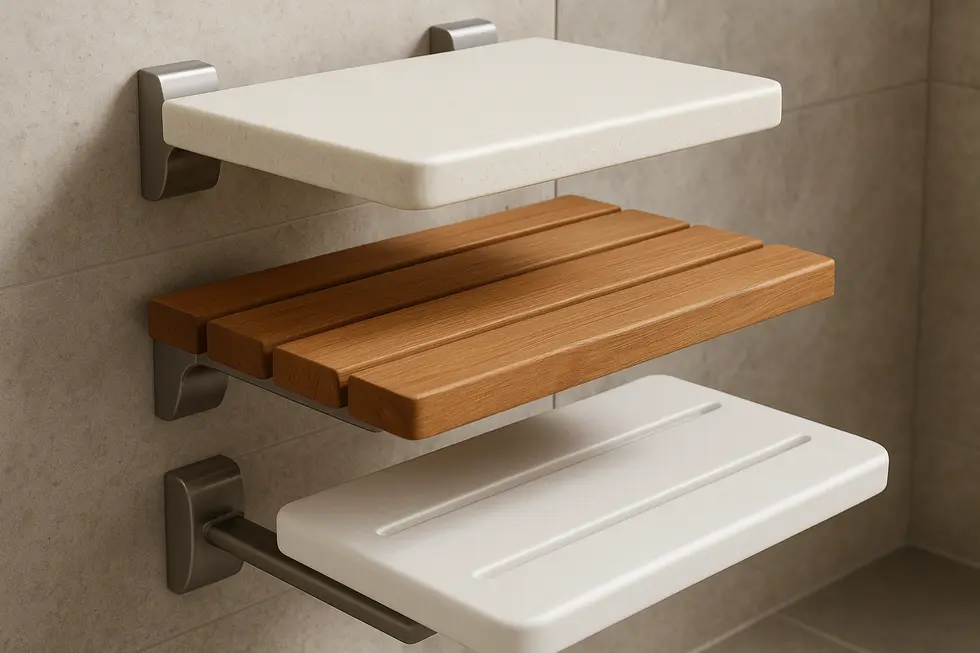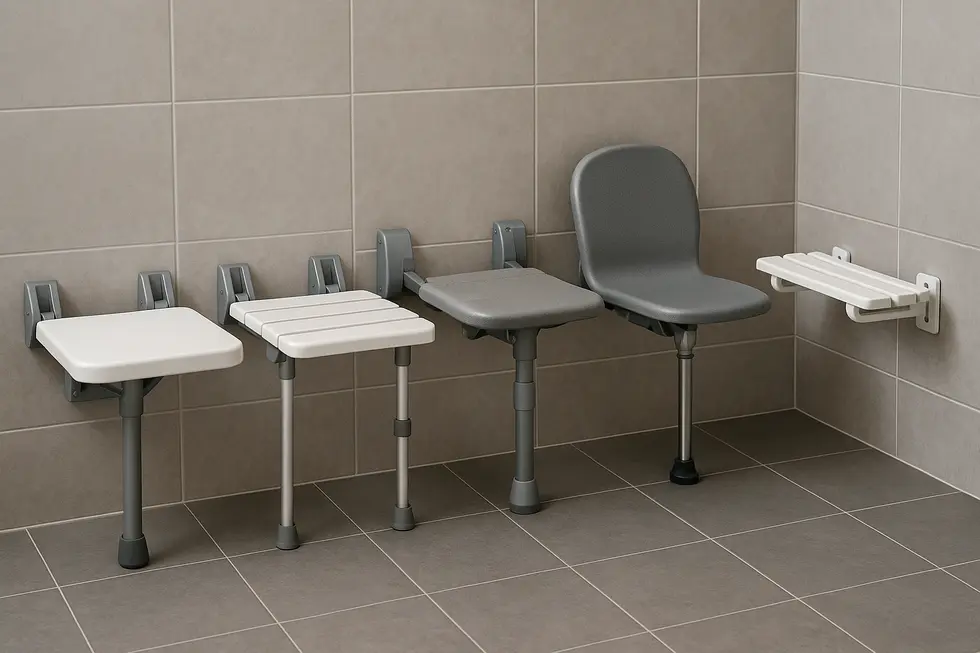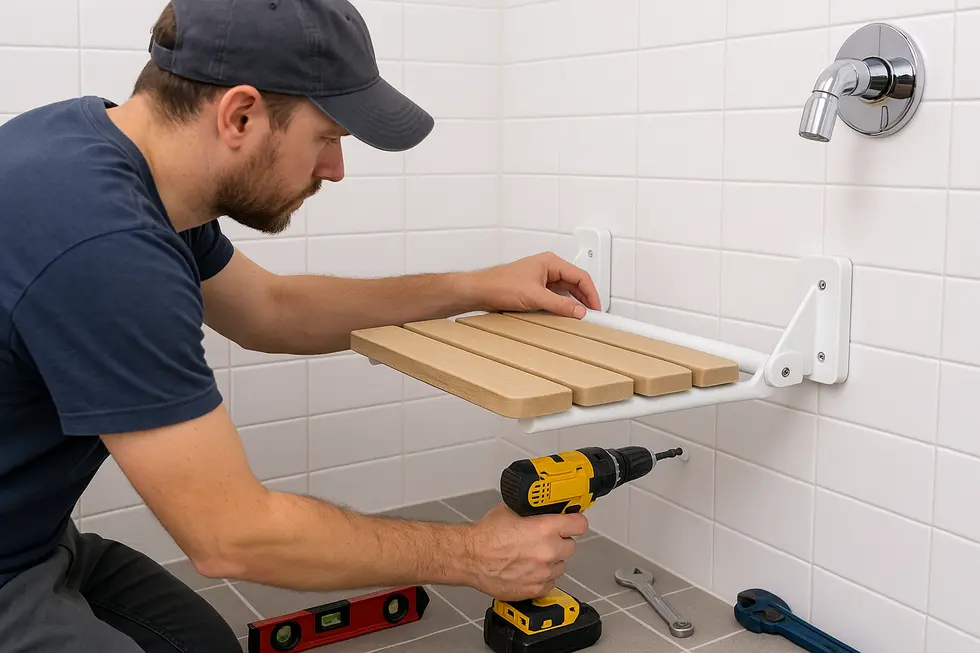Shower Seat
Choosing the Perfect Wall Mounted Shower Seat for Your Family
Selecting the right wall mounted shower seat involves more than just picking a style you like. For families, a shower seat must combine durability, safety, and ease of use, adapted to different needs from young to older members. This Wall Mounted Shower Seat Guide will journey through understanding material choices and their durability, assessing weight capacity along with safety features, and mastering installation and maintenance while considering costs. Whether you’re remodeling or buying for the first time, this Wall Mounted Shower Seat Guide offers essential insights to help you make an informed decision that prioritizes your family’s safety and comfort.
Building to Last: Choosing Materials That Keep Your Wall-Mounted Shower Seat Safe, Strong, and Stylish

Moisture never takes a day off, so the first defense for any wall-mounted shower seat is its frame. Opt for industrial-grade aluminum or marine-grade stainless steel brackets; both metals resist pitting, flaking, and the silent creep of corrosion that can compromise anchor strength. Powder-coated aluminum, in particular, gains a hybrid epoxy-polyester shell that shrugs off soap scum and coastal humidity alike while adding a clean satin finish.
The seat surface must match that resilience. High-density polyethylene (HDPE) remains a workhorse: it is non-porous, inexpensive, and immune to swelling, making it ideal for households that need a dependable seat on a budget. For a warmer, spa-like look, properly kiln-dried teak is unrivaled. Its natural oils repel water and mildew, but remember that those oils evaporate over time—wipe the wood dry after use and apply a penetrating sealant every few months to prevent cracking. Solid-surface composites blend powdered minerals with resins to create a seamless slab that visually merges with contemporary shower panels and can be lightly sanded to erase scratches.
No material choice matters if structural integrity is ignored. Verify that the manufacturer rates the seat for at least 20 percent more than the heaviest anticipated user—top-tier models routinely support 350 lb or more. Strength starts inside the wall, so anchor through studs or blocking; hollow drywall, even behind tile, will eventually fail.
Hygiene plays a quieter yet critical role in durability. Smooth finishes, drainage slots, and optional antimicrobial coatings discourage mold colonies that can weaken wood fibers and discolor plastics. Regular rinsing plus a weekly wipe with pH-neutral cleaner keeps surfaces in peak condition. For a deeper dive into balancing material strength with user protection, see safety considerations for wall-mounted shower seats.
Finally, consider the planet as well as your bathroom. FSC-certified teak and recyclable polymers reduce environmental impact, while retrofit-friendly mounting kits extend the life of existing tile work, cutting renovation waste.
Further independent guidance on corrosion-resistant fixtures is available in this concise overview of material advice on shower chairs.
Balancing Strength, Flexibility, and Peace of Mind: Mastering Weight Capacity, Adjustability and Safety When Choosing a Wall-Mounted Shower Seat

The numbers printed on a specification sheet are more than marketing trivia; they represent how confidently you can shift your weight in a wet, slippery space. Weight capacity is therefore the first non-negotiable filter. A seat rated for 250 lbs might work for many households, yet selecting a model that comfortably exceeds the heaviest expected user—often 350 lbs or more—adds a generous safety margin for changing health needs, extra clothing, or a caregiver’s supporting hand. Heavy-duty designs achieve capacities up to 500 lbs by pairing rigid stainless-steel frames with wide mounting plates that distribute force across several studs, reducing stress on any single fastener.
While raw strength keeps a seat anchored, adjustability makes it welcoming. A thoughtfully placed hinge lets you fold the platform flush against the wall, instantly freeing floor space for standing users or rolling equipment. Height flexibility—whether through telescoping brackets or pre-drilled mounting slots—turns a single seat into a custom perch. Setting the surface between 17 and 19 inches often aligns with wheelchair transfer height, but taller users may prefer 21 inches to avoid knee strain. Choosing hardware that can be repositioned later ensures the seat evolves with its owners rather than being ripped out when needs change.
Safety goes beyond sturdy screws. A gently textured surface fights hydroplaning without feeling abrasive against bare skin. Contoured front edges eliminate pressure points on the backs of thighs, promoting healthy circulation during longer showers. Integrated drainage slots channel water away so you are never sitting in a puddle that breeds mildew. Finally, look for an ADA-compliant fold-down profile; this guarantees the seat protrudes less than six inches when stowed, minimizing collision risk for someone who loses balance.
Even the best engineering fails if installation is sloppy. Always locate two or more solid studs, use corrosion-resistant lag bolts, and seal every penetration. For a fuller checklist, see this guide on safety considerations for wall-mounted shower seats. If you crave deeper engineering specifics, the publicly available detailed technical data offered by manufacturers such as Pressalit (https://pressalit.com) reveals load-distribution diagrams that underscore why proper anchoring is so critical.
By weighing capacity, fine-tuning height, and respecting installation physics, you transform a simple slab of material into a dependable partner in daily hygiene.
Anchoring Confidence: Installation, Upkeep, and Budgeting for Your Wall-Mounted Shower Seat

Securing a wall-mounted shower seat is more engineering than décor. The hardware may look modest, yet once occupied the seat must carry a live load that can easily exceed 300 lbs. For reliable support, the brackets have to bite into solid framing—preferably studs or a horizontal brace installed between studs before the wallboard went up. Tile alone, or tile over drywall, cannot shoulder that weight. If your chosen stud spacing does not align with the seat’s mounting holes, add a 2 × 10 backer behind the wall rather than trusting hollow-wall anchors. After dry-fitting the seat to confirm height—17–19 inches from the shower floor is common for comfortable transfers—drill pilot holes, inject a bead of waterproof sealant, and drive stainless-steel screws home. A subtle slope of one or two degrees back toward the wall encourages run-off so water drips instead of pooling.
Once the hinges fold smoothly and the cushion feels rigid, turn to upkeep. A quick wipe-down after each shower starves mildew of moisture. Solid-surface seats usually need only mild soap, while natural wood benefits from an oil treatment every few months to prevent cracking. Make a habit of tightening fasteners during that treatment; vibration and repeated folding can loosen them over time. Industry surveys suggest minor maintenance represents about 20 % of a fixture’s lifetime cost, but that number climbs sharply if early rust or mold is ignored.
Price tags vary almost as widely as designs. Entry-level plastic units start near $200, mid-range solid-surface models hover around $300, and premium hardwood versions with 500-lb ratings can exceed $400. Budget, however, is more than purchase price. Add reinforcement lumber, stainless screws, quality sealant, and—if you prefer to avoid tile drilling—professional labor that may double the outlay. Against those costs, weigh the savings of preventing a single bathroom fall. For many households, that peace of mind makes the seat the least expensive part of an accessible renovation.
If you need a clearer picture of framing layouts and screw placement, this concise step-by-step installation guide walks through the process. Detailed mounting dimensions can also be found in the manufacturer’s downloadable installation instructions.
Final thoughts
Bringing together all aspects of choosing a wall mounted shower seat, this guide highlights the essential factors for ensuring safety, comfort, and style for your family’s bathroom. By understanding the impact of materials, weight capacity, and proper installation, you’re equipped to make a decision that enhances both the functionality and aesthetics of your shower space.
Experience a new standard of clean with PEGABidet—designed for comfort, safety, and independence. Join thousands who trust us to make personal care simple and dignified. Contact us contact@pegabidet.com
About us
PEGABidet is a brand owned by L.A NEXTGEN LLC, based in California. We design intuitive, hygienic, and accessible bathroom solutions that prioritize safety, dignity, and independence. Our mission is to make personal care effortless and empowering for people at every stage of life.

